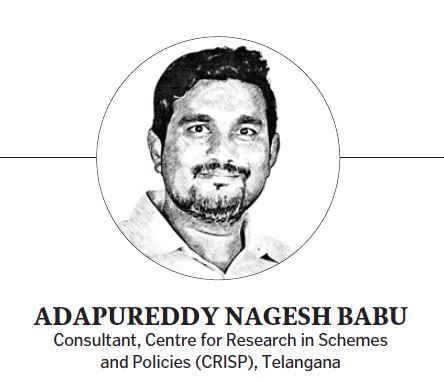India is not capable of employing more than half of its labour force, which points to a significant mismatch between academic qualifications and industry requirements
Updated On – 1 February 2024, 12:01 AM

By Adapureddy Nagesh Babu
India is in the midst of the demographic phase where the proportion of young within the population is higher and this will continue for another two to three decades. By employing a greater number of younger people in productive work, a country can effectively reap the demographic dividend. In the case of India, on the contrary, the proportion of younger people in the age 15-24 are increasingly out of the labour force.
In fact, according to the Centre for Monitoring Indian Economy (CMIE), only one-fifth of the people in this age group are either employed or seeking jobs. The remaining 80% are actually out of the job market. According to the ILO, the youth Labour Force Participation Rate (LFPR) in India stands at 28.1%. In comparison, youth LFPR is much higher in developing countries. According to the Periodic Labour Force Survey (PLFS) 2023, the unemployment rate among graduates in India is higher than in many other developing countries. This simply indicates that India is not capable of employing more than half of its labour force and 60% of the youth in a phase when the proportion of the younger population is much higher. These statistics highlight the alarming unemployment rates among graduates, pointing to a significant mismatch between academic qualifications and industry requirements.
Skill Gap
To bridge this gap, it is indispensable to integrate skilling into the mainstream education system. A shift in focus from theoretical knowledge to practical skills becomes crucial, considering the transformative impact of Industry 4.0 on the nature of evolving work and employment at a faster pace.
India’s quest to become a $10-trillion economy by 2030 necessitates a strategic approach to bridge the skills gap, and prepare the youth job-ready for Industry 4.0. Sectors like manufacturing, logistics, healthcare, BFSI, hospitality and life sciences are expected to witness substantial growth, creating millions of jobs.
It is expected that in the coming decade, 11 million manufacturing jobs will be created along with over 8 million jobs in hospitality by 2028 and 3.5 million green jobs by 2030 fuelling demand for a skilled workforce. (Aditya Ghosh, Chairman of CII National Committee on Skill Development & Livelihood). This involves sectoral identification of future jobs, carefully aligning educational programmes with industry needs, and ensuring that graduates possess the requisite skill sets.
Transferrable Skills
As the demand for skilled labour continues to grow through technological advancements, employers increasingly require employees who possess more than just bookish knowledge. Research published in ‘The Journal of Further and Higher Education’ emphasises the importance of developing key transferable skills in students. It stresses the fact that employers prioritise candidates with practical abilities such as problem-solving and creative thinking, highlighting the necessity for integrated skill sets.
Integrating skills with higher education curriculum refers to the process of combining knowledge acquired from formal educational training within an academic setting with appropriate industry-specific work practices and requirements necessary for one’s intended career. Through this incorporation and enrichment of current subject matter, graduates become prepared for further study, future job opportunities as well as longer-term professional success within their chosen field. Employers seek candidates with a balance of soft skills and technical qualifications, making graduates more competitive in the job market.
Higher education institutions (HEIs) must bring in experts from industry to their laboratories so that students are aware of the developments on the ground. Regular seminars and classes, apprenticeships/internships, on-the-job training and live projects are also excellent ways to learn the industry’s inner workings. Over time, this will allow academia to update existing learnings with newer methodologies and ensure an advanced pedagogy. This will prepare students for real-world challenges and provide them with a competitive edge in the job market.
The India Skills Report 2024 identifies States like Telangana, Kerala, Haryana, Maharashtra, Andhra Pradesh and Uttar Pradesh as having a higher concentration of employable talent. As per the report, Telangana has the highest concentration of employable talent in the age group of 18-21 with 85.45% found employable in this group. Telangana has the potential not only to drive its growth but also to fuel the national economy through its employable youth.
Collaborative Innovation
The current scenario underscores the necessity of a curriculum that transcends traditional boundaries, integrating practical skilling component that aligns with the demands of the everchanging job market. A balanced education system, focusing on both academic proficiency and practical acumen, equips individuals to navigate the complexities of the professional world. The synergy between academia and industry not only prepares students for real-world challenges but also ensures that academic research remains relevant and impactful. This collaborative spirit serves as a catalyst for innovation, with academia contributing theoretical insights and industry providing practical applications. To bridge the gap between academia and industry, a symbiotic relationship is essential.
According to consulting firm McKinsey, around 69% of companies globally are focusing on skill-building and more than 50% believe that the pandemic and the challenges it threw up have increased the demand for a multi-skilled workforce. According to an Accenture report, ‘Fueling India’s Skill (R)evolution’, the country could lose 2.3% of its annual growth by 2028 if skill-building is not on a par with modern technological interventions. While our higher education system is currently undergoing several changes, the growing need for seamless coordination of a classroom-based curriculum and practical skills-based learning demands that our institutions and academicians begin designing a different kind of curriculum that focuses on research, development and training.
Embedding skilling into the curriculum is not just a policy imperative; it’s a strategic need to prepare the youth for the challenges and opportunities of the future. A proactive and collaborative approach will ensure that higher education becomes a powerful tool in empowering students through employability and fuelling the economic growth of the nation.





